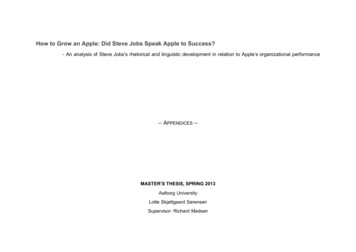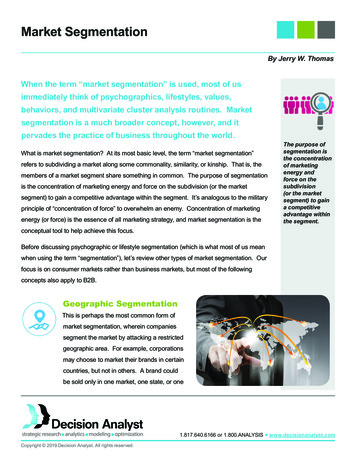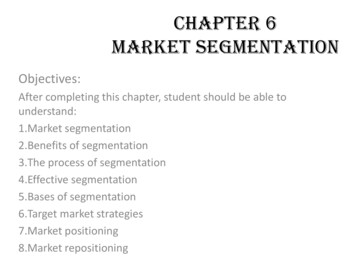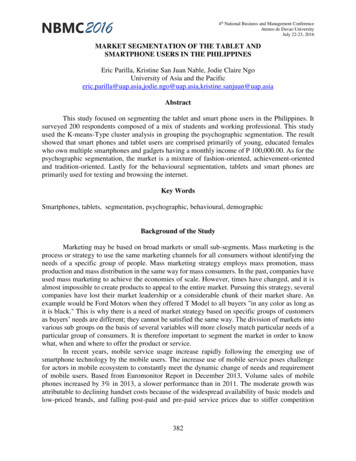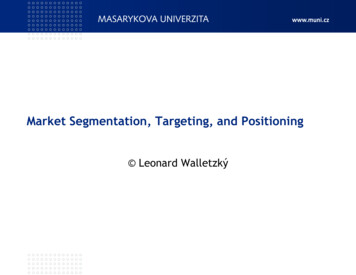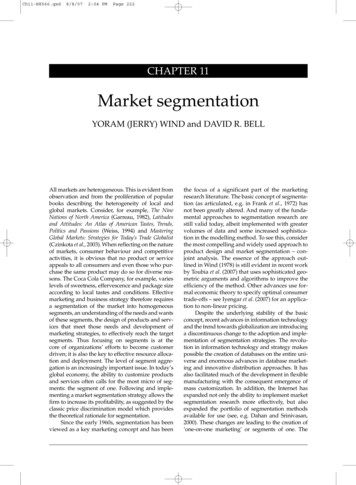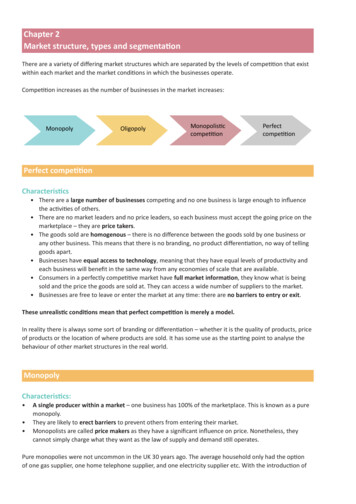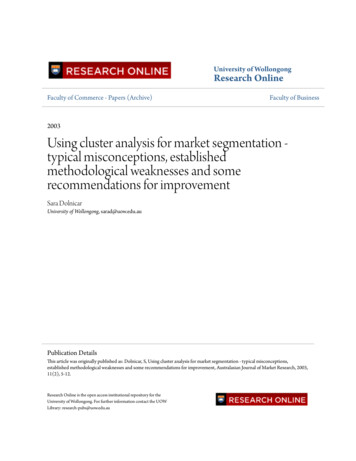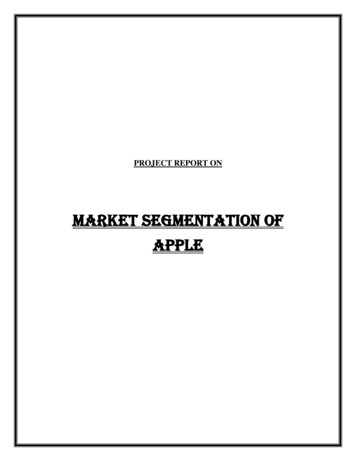
Transcription
PROJECT REPORT ONMARKET SEGMENTATION OFAPPLE
IntroductionEver wondered why marketers only target certain markets or how these marketsare identified? Think about universities for a moment: how do they identify whichstudents to communicate with about degree schemes? What criteria do they use?Do they base it on where you live, your age, your gender, or is it just about yourentrance scores? Do they market to postgraduate and undergraduate audiencesdifferently, what about international and domestic student groups—is this difference important for the effective marketing of higher education services toprospective students?In this chapter, we consider the way organizations determine the markets inwhich they need to concentrate their commercial efforts. This process is referredto as market segmentation and is an integral part of marketing strategy, discussedin Chapter 5. After defining the principles of market segmentation this chaptercommences with an exploration of the differences between market segmentationand product differentiation, as this helps clarify the underlying principles of segmentation. Consideration is also given to the techniques and issues concerningmarket segmentation within consumer and business-to-business markets.The method by which whole markets are subdivided into different segmentsis referred to as the STP process. STP refers to the three activities that should beundertaken, usually sequentially, if segmentation is to be successful. These aresegmentation, targeting, and positioning, and this chapter is structured aroundthese key elements.The STP ProcessThe growing use of the STP process has occurred as a direct result of the prevalenceof mature markets, the greater diversity in customer needs, and the ability toreach specialized or niche segments. As such marketers are increasingly segmenting markets and identifying attractive segments (i.e. who to focus on and why?),in order to identify new product opportunities, develop suitable positioning andcommunications strategies (i.e. what message to communicate), and effectivelyallocate resources to key marketing activities (i.e. how much should we spendand where?). Organizations will often commission segmentation research when
they want to re-scope their marketing strategy, investigate a declining brand, launch anew product, or restructure their pricing policy. Organizations operating in highly dynamic environments seek to conduct segmentation research atregular intervals, to keep in touch with changes in the marketplace.STP refers to the three activities segmentation, targeting, and positioning (Figure6.1).Key benefits of the STP process include: Enhancing a company‟s competitive position by providing direction and focus formarketing strategies such as targeted advertising, new product development,and brand differentiation. For example, Coca-Cola identified through marketresearch that its Diet Coke brand (also marketed as Coca-Cola Lite) was regarded as „girly‟and „feminine‟ by male consumers. As a direct result the company developed a newproduct, branded Coke Zero, which is targeted at the health-conscious male segment of thesoft drinks market. Examining and identifying growth opportunities in the market through theidentification of new customers, growth segments, or new product uses. Forexample Arm & Hammer was able to attract new customers when existing consumersidentified new uses for their baking soda (Christensen, Cook, and Hall, 2005). Lucozadealso changed the positioning and targeting from its original marketing strategy positionedfor sick children and rebranded to target athletes as an energy drink. More effective and efficient matching of company resources to targetedmarket segments promises the greatest return on marketing investment(ROMI). For example, financial institutions like HSBC and Barclays and large retailingmultinationals such as Tesco and ASDA Wal-Mart are utilizing data-informedsegmentation strategies to effectively target direct marketing messages and rewards tocustomers they have classified as offering long-term value to the company, i.e. they areprofitable customers.
The Concept ofMarket SegmentationMarket segmentation is the division of a market into different groups of customers withdistinctly similar needs and product/service requirements. Or to put it another way, marketsegmentation is the division of a mass market into identifiable and distinct groups orsegments, each of which have common characteristics and needs and display similarresponses to marketing actions.Market segmentation was first defined as „a condition of growth when coremarkets have already been developed on a generalised basis to the point where shingreturns‟(Smith,1956). There is now widespread agreement that they form an important foundation for successful marketing strategies and activities (Wind, 1978; Hooley andSaunders, 1993).The purpose of market segmentation is to leverage scarce resources; in otherwords, to ensure that the elements of the marketing mix, price, distribution, products and promotion, are designed to meet particular needs of different customergroups. Since companies have finite resources it is not possible to produce all possible products for all the people, all of the time. The best that can be aimed for isto provide selected offerings for selected groups of people, most of the time. Thisprocess allows organizations to focus on specific customers‟ needs, in the mostefficient and effective way. As Beane and Ennis (1987) eloquently commented,„a company with limited resources needs to pick only the best opportunities topursue‟.The market segmentation concept is related to product differentiation. If youaim at different market segments, you might adapt different variations of youroffering to satisfy those segments, and equally if you adapt different versions ofyour offering, this may appeal to different market segments. Since there is lesscompetition, your approach is less likely to be copied and so either approach will do.An example in the area of fashion retailing might be if you adapt your clothing range so that your skirts are more colourful, use lighter fabrics, and a veryshort hemline, for instance, this styling is more likely to appeal more to youngerwomen. If alternatively, you decide to target older women, then you might need
to change the styling of your skirts to suit them by using darker, heavier fabrics,with a longer hemline. This is exactly what Marks and Spencer (M&S) did toattract a younger female shopper into their M&S stores and compete more directlywith Next and Debenhams for share of this market. The company launched arange of female clothing called Per Una, and three years on the fashion range hasbeen a huge success reportedly generating annual sales of nearly 230 m—morethan 10 per cent of the total womenswear sales at M&S. If you start by adaptingnew product variants, you are using a product differentiation approach. If youstart with the customer‟s needs, you are using a market segmentation approach.This is illustrated more clearly in Figure 6.2 using offering rather than product toindicate that the same concept may apply to a service.A relational marketing perspective would replace the marketing mix—the 4Ps —eitherwith the 7Ps or with a discussion of the need to design, develop, and deliver the customerexperience.The concept of market segmentation was first proposed as an alternative marketdevelopment technique in imperfectly competitive markets, that is, in marketswhere there are relatively few competitors selling an identical product. Wherethere are lots of competitors selling identical products, market segmentation andproduct differentiation produce similar results as competitors imitate your strategic approach more quickly and product differentiation approaches meet marketsegment needs more closely.With an increasing proliferation of tastes in modern society, consumers haveincreased disposable incomes. As a result, marketers have sought to design product and service offerings around consumer demand (market segmentation) morethan around their own production needs (product differentiation) and they usemarket research to inform this process.
A Tale of Two ApproachesTale 1 is about Amway, a global company that manufactures and distributes over 450different consumer products and invests heavily in research and development in order toremain competitive and meet customer needs. For example, after several years of researchand development, Amway produced a new range of products called Satinique, which usedthe „Ceramide Infusion System‟. The core attribute is that Satinique contains a moisturizingagent, which can restore the nutrients in hair. Once Amway had developed the product theythen undertook market research to determine which group of consumers they should target.Having identified a segment made up of professional women, who always want to look theirbest and who want professional, salon- quality products and who rely on recommendationsfrom friends when making haircare purchase decisions, they then developed a marketingstrategy and implemented a successful marketing plan.There are three main usage segments in the sun care market: protection (from harmful rays),after sun (for relief and moisturizing after being in the sun), and self-tan (for those who wantan all year round „cosmetic‟ tan). Beiersdorf have developed their portfolio of NIVEA Sunbrands around these usage segments, but unlike Amway have used innovationto develop products to meet customer needs identified through market research andsegmentation analysis. For example, market research has shown that awareness of the needfor protection from the sun does not necessarily lead to product purchase and usage. It wasalso found that women enjoy the luxurious nature of sun care products, men preferconvenience, and children don‟t enjoy the sun cream application process. As a result NIVEASun developed and introduced a spray application device, designed specifically to appeal tomen and their preference for convenience. They also introduced a coloured formulation forchildren‟s sun products in order to make the application process more fun.1 Which of these two companies use a product differentiation approach and which uses amarket segmentation approach? Justify your selection.2 Choose a beauty, fragrance, or grooming product that you like to use and determine likelysegments. 3 Do you believe Amway should change their approach? Justify your decision.Market segmentation which put forward the idea that because neither supply nor demandsides of marketing were homogeneous (i.e. different groups wanted to produce andconsume different things), a product differentiation approach which was concerned withthe bending of demand to the will of supply must also be accompanied by an alternative
mechanism of the bending of supply to the will of demand. This alternative marketingstrategy was termed market segmentation.The Process of Market SegmentationThe intricacies involved in market segmentation are said to make it an exacting activity.Griffith and Pol (1994) argue this point on the basis of multiple product applications,greater customer variability, and problems associated with the identification of the keydifferences between groups of customers. However, there have been numerous attempts todefine and describe business segmentation, using a variety of variables and ranging fromthe severely product-based to customer needs-based orientation.There are two main approaches to segmenting markets. The first adopts theview that the market is considered to consist of customers which are essentiallythe same, so the task is to identify groups which share particular differences.This is referred to as the breakdown method. The second approach considersa market to consist of customers that are all different, so here the task is to findsimilarities. This is known as the build-up method. The breakdown approach isperhaps the most established and well recognized and is the main method usedfor segmenting consumer markets. The build-up approach seeks to move fromthe individual level where all customers are different, to a more general level ofanalysis based on the identification of similarities. The build-up method is customeroriented as it seeks to determine common customer needs. The aim of both methods is toidentify segments in the market where identifiable differences exist between segments(segment heterogeneity) and similarities exist between members within each segment(member homogeneity).Other segmentation researchers have distinguished between a priori or post hocsegmentation methods (Green, 1979). In the former, segments are predetermined usingthe judgement of the researchers beforehand (i.e. a priori). This approach typicallyprogresses along seven stages encompassing the following steps (Wind, 1978) including:1 Selection of .g.demographics,2 Selection of segment descriptors (including hypotheses on the possible linkbetween these descriptors and the basis for dsamplingapproachesand
occasionally a quota sample (see Chapter 4).4 Data collection.5 respondentsinto6 Establishment of the profile of the segments using multivariate statisticalmethods (e.g. multiple discriminate analysis, multiple regression analysis).7 Translation of the findings about the segments‟ estimated size and profile into specificmarketing strategies, including the selection of target segments and the design ormodification of specific marketing strategy.With the post hoc approach, the segments are deduced from the research and insteadpursue the following process:1 Sample design—mostly using quota or random sampling approaches2 Identification of suitable statistical methods of analysis. 3 Data collection.4 Data
and brand differentiation. For example, Coca-Cola identified through market research that its Diet Coke brand (also marketed as Coca-Cola Lite) was regarded as „girly‟ and „feminine‟ by male consumers. As a direct result the company developed a new product, branded Coke Zero, which is targeted at the health-conscious male segment of theFile Size: 601KBPage Count: 33
